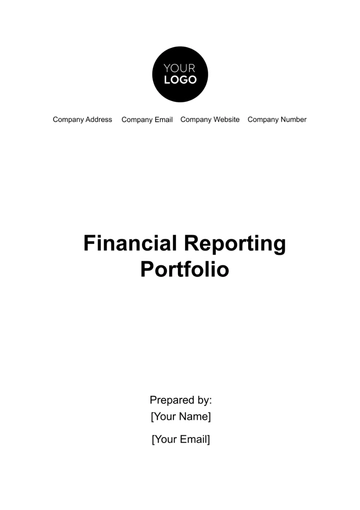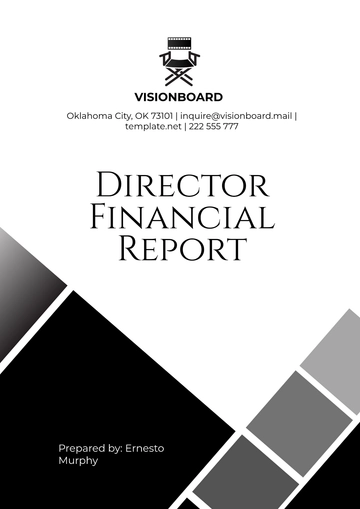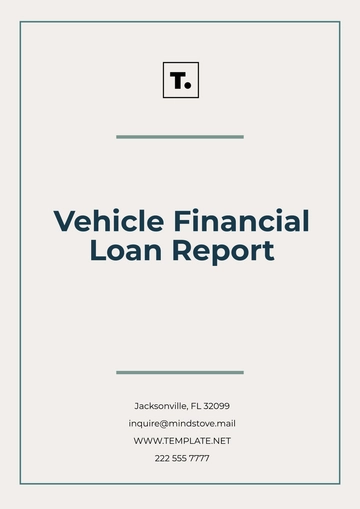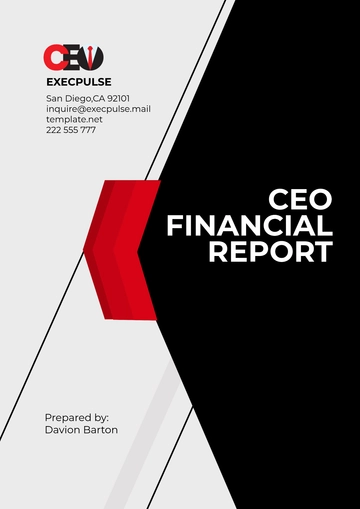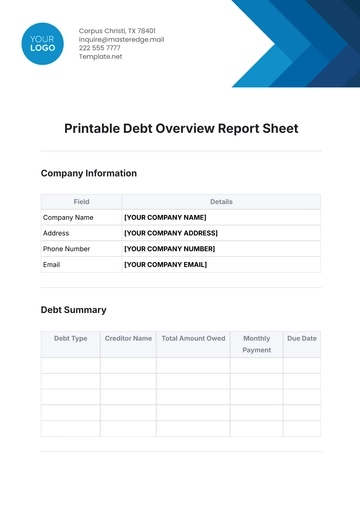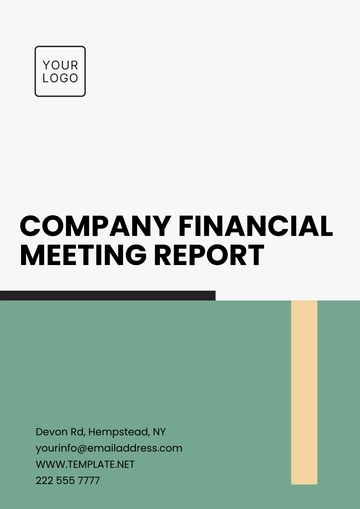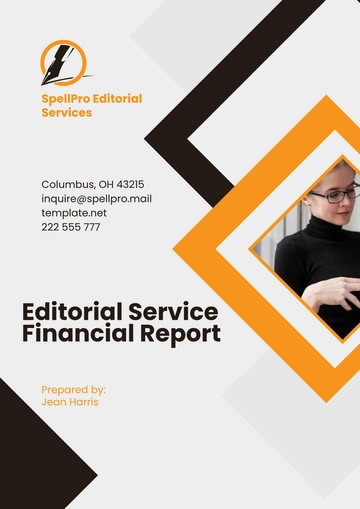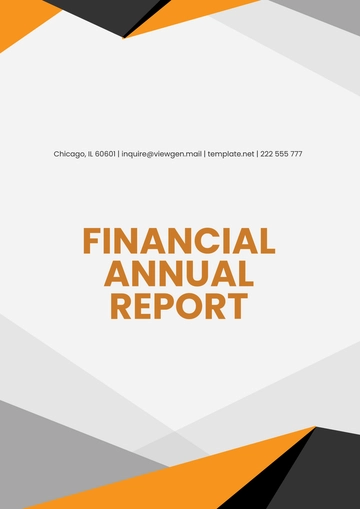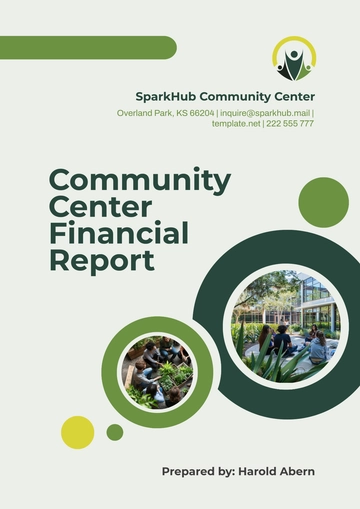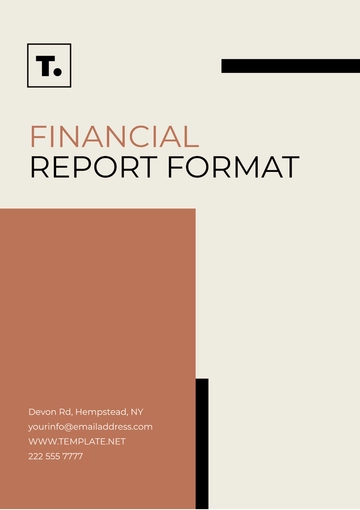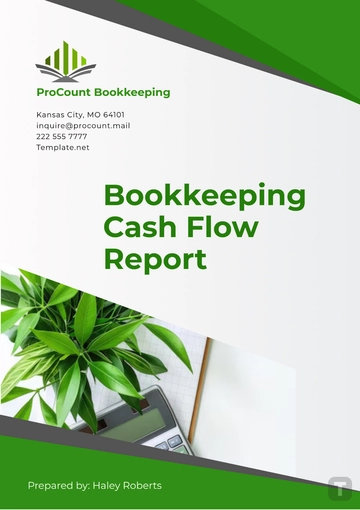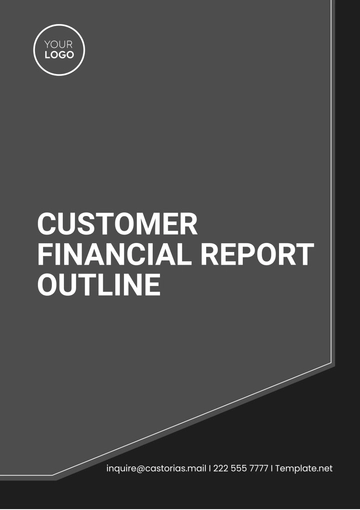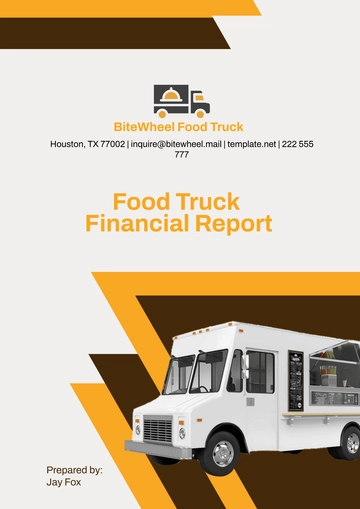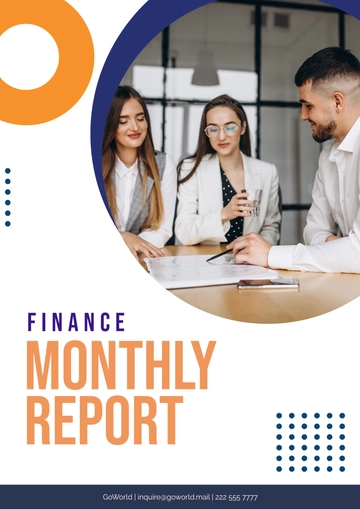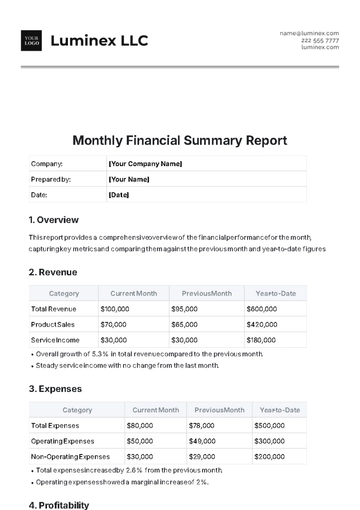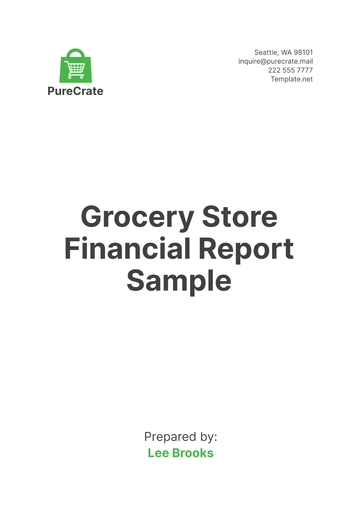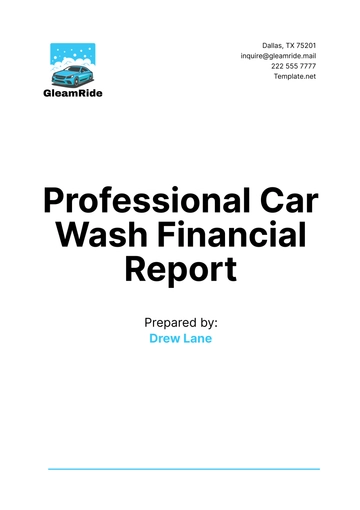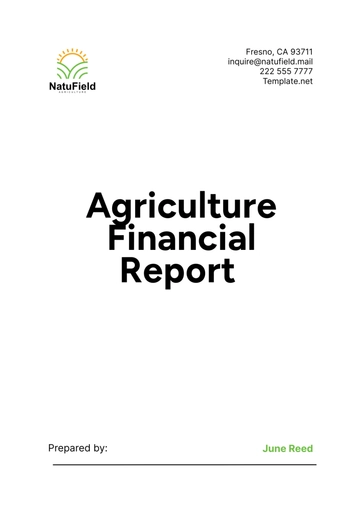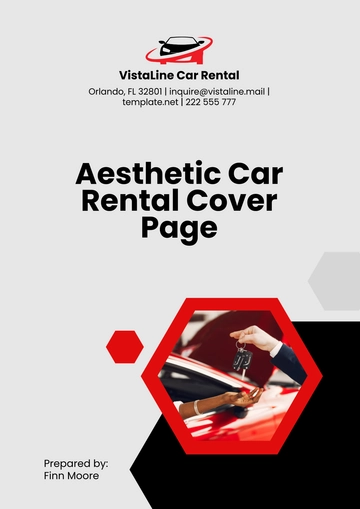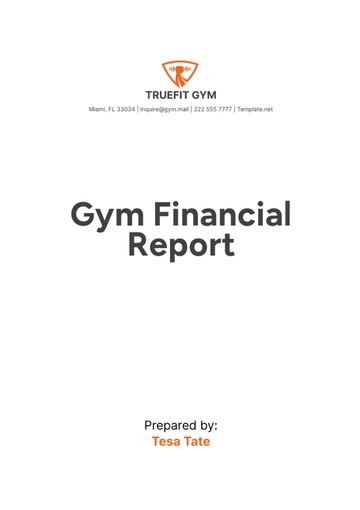Free Driving School Financial Report
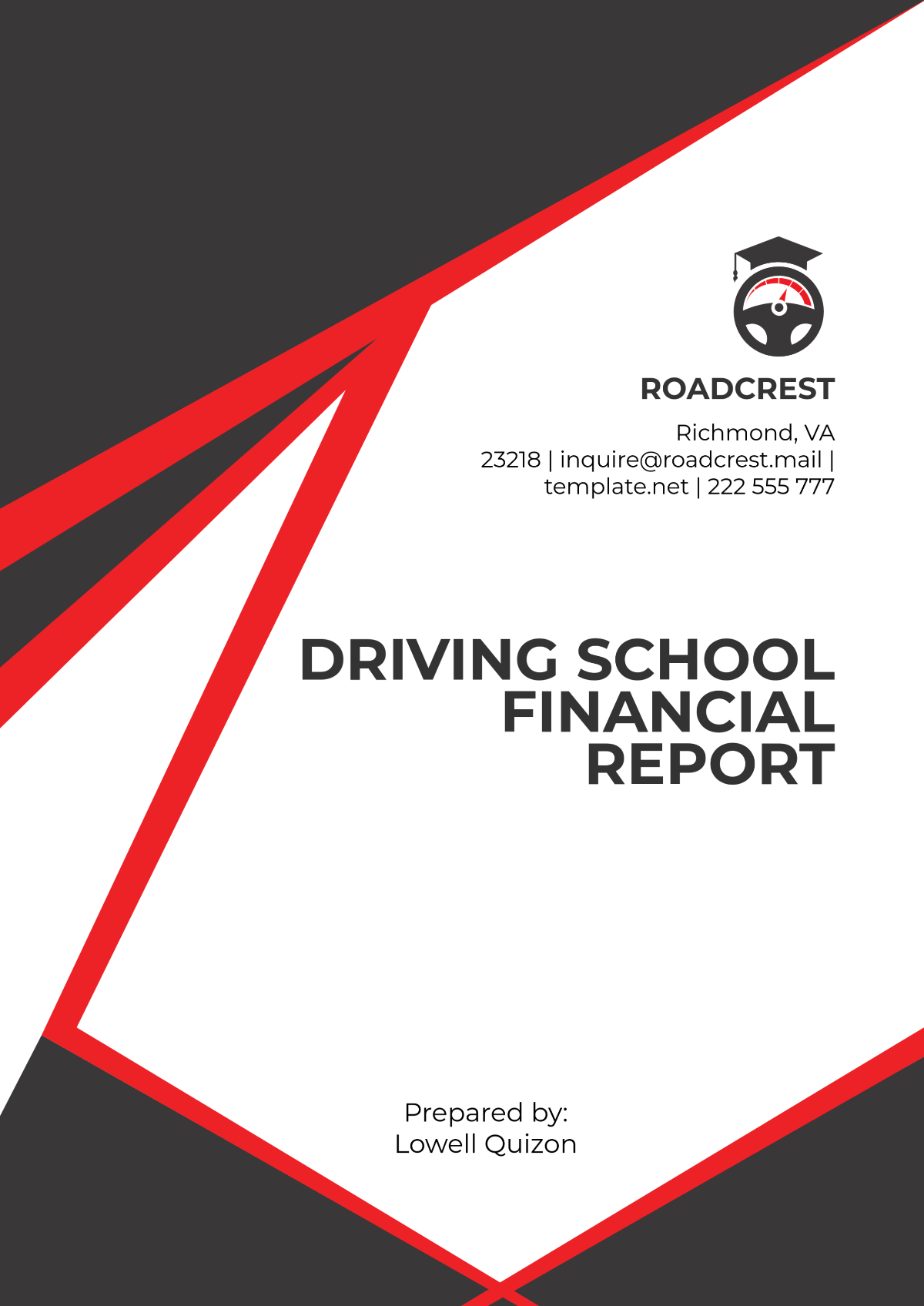
I. Executive Summary
A. Overview of the Report
This report provides a comprehensive financial analysis of [Your Company Name] for the year 2049. The purpose of the report is to review our revenue, expenses, profitability, and overall financial health. It will also assess our performance in comparison to previous periods, as well as offer projections for the upcoming year.
B. Purpose of the Financial Report
The report aims to give insight into our operational efficiency and financial stability. We will identify areas of growth and areas requiring improvement, ensuring that we remain competitive in the market. Additionally, the report supports decision-making processes for future strategic planning.
C. Key Financial Highlights
In 2049, [Your Company Name] generated $[00] million in revenue, a [00]% increase from 2048. Expenses totaled $[00] million, with a net profit margin of [00]%. We successfully reduced operating costs while increasing our student base by [00]%, contributing to strong financial performance.
II. Business Overview
A. Description of the Driving School
[Your Company Name] is a well-established driving school offering professional driving lessons and road safety courses. We operate across multiple locations in the city, with an additional online platform for virtual driving courses. Our mission is to provide high-quality education and support to aspiring drivers of all ages.
B. Mission, Vision, and Values
Our mission is to empower individuals with the skills and knowledge necessary to drive safely and responsibly. We envision becoming the leading provider of driving education in the region by 2055. Our core values include safety, integrity, customer satisfaction, and community engagement.
C. Services Provided
We offer a variety of services, including behind-the-wheel driving lessons, theory courses, road test preparation, and advanced driver safety programs. We also provide vehicle rentals for road tests and offer customized packages for corporate driving training. Our online platform has seen significant growth, with virtual theory classes becoming a popular option.
D. Target Market and Customer Demographics
Our target market consists of individuals aged 18-60, including teenagers seeking their first driving experience and adults needing refresher courses. We also cater to corporate clients looking to train employees on safe driving practices. Our primary customer base is from urban and suburban areas, with a growing demand for online services.
E. Summary of Key Achievements in the Reporting Period
In 2049, we expanded to two new locations and saw a [00]% increase in online course registrations. Additionally, we successfully launched a fleet of electric vehicles for eco-conscious drivers. Our customer satisfaction rate reached [00]%, a reflection of our commitment to quality service.
III. Revenue Analysis
A. Total Revenue for the Period
In 2049, the total revenue generated by [Your Company Name] amounted to $[00]. This represents a [00]% increase over 2048's revenue of $[00]. The growth was primarily driven by the expansion of online courses and increased demand for advanced driver safety programs.
B. Breakdown of Revenue Streams
The revenue breakdown for 2049 is as follows:
Revenue Stream | Amount | Percentage of Total Revenue |
|---|---|---|
Driving Lessons | $800,000 | 53% |
Online Courses | ||
Road Test Preparation & Rentals | ||
Corporate Training Programs |
C. Comparison to Previous Periods
Compared to 2048, the revenue from driving lessons and online courses increased significantly by [00]% and [00]%, respectively. Corporate training programs remained steady, while road test preparation saw a slight decline. Overall, 2049's revenue growth was driven by a broader market reach and diversified service offerings.
D. Revenue Trends and Insights
The growing popularity of online courses aligns with broader trends in education and e-learning. Moreover, the shift towards eco-friendly vehicles has created new opportunities in sustainable driving lessons, which contributed to the increase in student registrations. We plan to further capitalize on these trends in the upcoming years.
IV. Expense Breakdown
A. Total Expenses for the Period
Our total expenses for 2049 amounted to $[00], a [00]% increase from the previous year. This increase was mainly due to the expansion of locations and the higher costs of vehicle maintenance and insurance. However, we maintained effective cost control in other operational areas.
B. Categories of Expenses
The following table shows the breakdown of our expenses:
Expense Category | Amount | Percentage of Total Expenses |
|---|---|---|
Instructor Salaries and Wages | $400,000 | 36% |
Vehicle Maintenance & Insurance | ||
Rent and Utilities | ||
Marketing & Advertising | ||
Office Supplies & Administrative | ||
Licensing & Regulatory Fees | ||
Employee Benefits & Training |
C. Comparison to Previous Periods
Instructor salaries accounted for the largest portion of expenses, which increased by [00]% due to higher wages and more hired instructors. Vehicle-related expenses increased by [00]% due to the addition of new vehicles, including electric models. Rent and utilities remained consistent, reflecting stable lease agreements.
D. Expense Trends and Areas of Concern
The rising cost of vehicle insurance is an area of concern, prompting us to explore alternative insurance providers. We anticipate that as our fleet grows, insurance premiums will continue to rise unless mitigated by strategic partnerships. We are also focusing on improving operational efficiency to offset increasing expenses.
V. Profit and Loss (P&L) Statement
Item | Amount |
|---|---|
Total Revenue | $1,500,000 |
Total Expenses | |
Operating Profit (EBIT) | |
Net Profit (After Taxes) | |
Net Profit Margin |
A. Total Revenue
In 2049, [Your Company Name] generated total revenue of $[00], reflecting a robust growth of [00]% compared to 2048. The increase was driven by higher enrollment rates in both traditional and online courses. Our strategic expansion into electric vehicle lessons also contributed to the revenue boost, attracting more eco-conscious drivers.
B. Total Expenses
Our total expenses in 2049 amounted to $[00], up [00]% from 2048. The largest expense category was instructor salaries, which accounted for [00]% of total costs. The rise in vehicle maintenance costs, driven by the addition of electric vehicles to our fleet, also contributed to the increase in expenses.
C. Operating Profit (EBIT)
Operating profit (EBIT) stood at $[00], reflecting a healthy operating margin of [00]%. This was an improvement over the previous year’s EBIT of $[00], demonstrating our ability to control costs while expanding services. The increase in profitability was a direct result of efficient cost management and an increase in demand for both physical and online lessons.
D. Net Profit (After Taxes and Other Adjustments)
After taxes and other adjustments, our net profit for 2049 reached $[00], or a [00]% profit margin. This was a positive outcome, as it exceeded the industry average of [00]%. The strong profit performance was also supported by careful management of administrative costs and a reduction in customer acquisition expenses.
E. Profit Margins
Our net profit margin of [00]% is a strong indicator of the school’s financial health. Compared to the industry average of [00]%, this places us in a competitive position. In 2050, we aim to increase the profit margin further by optimizing operational efficiencies and expanding high-margin services like online courses.
F. Comparison to Industry Benchmarks
The profit margins and operating efficiency of [Your Company Name] surpass industry benchmarks. Our [00]% revenue growth and [00]% increase in expenses are aligned with the trends of growth in the driving school sector. Maintaining these figures is crucial for sustaining our competitive advantage.
VI. Balance Sheet
Assets | Amount | Liabilities | Amount |
|---|---|---|---|
Current Assets | $500,000 | Short-term Liabilities | $100,000 |
Fixed Assets (Vehicles, Property) | |||
Intangible Assets (Goodwill) | |||
Total Assets |
A. Assets
The company’s total assets reached $[00] in 2049, comprising $[00] in current assets and $[00] in fixed assets. Fixed assets primarily consist of vehicles used for driving lessons and property for our office locations. Intangible assets, mainly goodwill generated through positive brand reputation and customer loyalty, amounted to $[00].
B. Liabilities
Liabilities for 2049 totaled $[00], consisting of $[00] in short-term liabilities and $[00] in long-term liabilities. Short-term liabilities include accounts payable and some outstanding operating expenses. Long-term liabilities are mainly loans taken to finance the expansion of our fleet of vehicles and to secure new office spaces in growing areas.
C. Equity
The equity section of the balance sheet reflects a healthy position with total equity standing at $[00]. This equity is primarily derived from retained earnings, as well as new investments made by the owner. The strong equity base ensures that [Your Company Name] is well-positioned for future growth and expansion.
D. Total Assets and Liabilities
The total assets and liabilities show a balanced financial position, with assets exceeding liabilities by $[00]. This indicates the company is in a strong solvency position and has sufficient resources to cover its liabilities and invest in future opportunities.
E. Comparison to Previous Period
Compared to 2048, assets increased by [00]%, primarily due to the acquisition of new vehicles and office equipment. Liabilities grew by [00]% as the company expanded its borrowing to finance new investments. The increase in both assets and liabilities reflects a deliberate and strategic expansion plan.
VII. Cash Flow Statement
Item | Amount |
|---|---|
Cash Flow from Operating Activities | $400,000 |
Cash Flow from Investing Activities | |
Cash Flow from Financing Activities | |
Net Cash Flow |
A. Cash Flow from Operating Activities
Cash flow from operating activities for 2049 was $[00], a positive outcome supported by strong sales and efficient cost management. Increased customer registrations for both driving lessons and online courses contributed to the healthy cash flow. Additionally, the expansion of our corporate training programs further boosted cash receipts.
B. Cash Flow from Investing Activities
Cash flow from investing activities was negative at -$[00], reflecting investments in new vehicles and property upgrades. These investments were necessary to support the expansion of services and to meet the growing demand for driving lessons. In the future, we plan to balance investments with cash flow generation to maintain financial stability.
C. Cash Flow from Financing Activities
The company had a net cash inflow of $[00] from financing activities, which was primarily generated through a short-term loan to cover new capital expenditures. This loan is part of our ongoing effort to manage growth without compromising financial stability. We plan to continue using a combination of equity and debt financing to fund future growth.
D. Net Cash Flow for the Period
Net cash flow for the year amounted to $[00], indicating a strong financial position. The positive cash flow allows us to reinvest in the business, covering both operational needs and planned capital expenditures. We aim to improve cash flow further in 2050 by increasing operational efficiencies and reducing unnecessary expenses.
VIII. Key Performance Indicators (KPIs)
KPI | 2049 Value | Target Value for 2050 |
|---|---|---|
Revenue Per Lesson | $75 | $80 |
Customer Acquisition Cost | ||
Profit Margin | ||
Instructor Utilization Rate | ||
Customer Retention Rate |
A. Revenue Per Lesson
The revenue per lesson in 2049 stood at $[00], which was a [00]% increase from the previous year. This growth reflects our ability to charge premium rates for specialized lessons, including advanced driving courses and electric vehicle lessons. We aim to increase this further by improving customer offerings and increasing the price of select services in 2050.
B. Customer Acquisition Cost
The cost of acquiring a new customer in 2049 was $[00], a reduction from the previous year due to more efficient marketing strategies. We plan to bring this cost down further by leveraging digital marketing tools and expanding our referral programs. A lower acquisition cost will directly improve profitability as we continue to scale.
C. Profitability Ratios
Our profitability ratios for 2049 indicate a strong financial performance, with a net profit margin of [00]% and operating profit margin of [00]%. These ratios are higher than the industry average, reflecting the efficiency of our operations and the quality of our service offerings. We aim to further optimize our operations to achieve a [00]% profit margin in 2050.
D. Instructor Utilization Rate
The instructor utilization rate stood at [00]%, which is an efficient use of resources given our fleet and student enrollment. Our goal is to increase this rate to [00]% by hiring more part-time instructors and increasing lesson bookings during off-peak hours. This will help maximize revenue per instructor.
E. Customer Retention Rate
Our customer retention rate reached [00]%, reflecting our high level of customer satisfaction. This is a testament to the quality of our training and customer service. For 2050, we aim to increase this retention rate to [00]% by introducing loyalty programs and personalized driving education experiences.
IX. Financial Forecast and Projections
A. Projected Revenue for the Next Period
For 2050, we project a revenue growth of [00]%, reaching approximately $[00] million. This growth is expected to be driven by a [00]% increase in online course enrollments and the continued demand for eco-friendly vehicle training. Additionally, we anticipate a steady increase in corporate training programs as businesses invest in safe driving initiatives for their employees.
B. Projected Expenses and Profitability
We project a [00]% increase in expenses for 2050, totaling around $[00] million. The increase in expenses will be mainly attributed to the expansion of our fleet and the opening of two additional locations. Despite the rise in costs, we anticipate maintaining a healthy profit margin of [00]% due to improved efficiency and a higher average revenue per customer.
C. Strategic Financial Goals
Our financial goals for 2050 include increasing overall revenue by [00]%, reducing customer acquisition costs by [00]%, and maintaining an operating profit margin above [00]%. We also aim to diversify our revenue streams by introducing new programs such as defensive driving and eco-driving certifications. These initiatives will help ensure sustainable growth in the long term.
X. Conclusion
A. Summary of Key Findings
In 2049, [Your Company Name] showed robust financial growth, with a revenue increase of [00]% and a net profit margin of [00]%. The strategic expansion of online services and corporate training programs were key contributors to this success. Our ability to control costs and improve operational efficiency allowed us to achieve these results.
B. Recommendations for Improving Financial Performance
To improve financial performance in 2050, we recommend focusing on reducing vehicle maintenance costs and expanding our fleet with electric vehicles. We also suggest exploring new revenue opportunities in the form of driver safety certifications and expanding partnerships with local businesses for employee training.
C. Strategic Considerations for the Future
Looking forward, [Your Company Name] is well-positioned to grow by capitalizing on the increasing demand for online education and eco-conscious driving. Continued investment in technology and strategic marketing will be essential to achieving our financial goals. By focusing on customer satisfaction, cost control, and service expansion, we expect continued growth and profitability.
- 100% Customizable, free editor
- Access 1 Million+ Templates, photo’s & graphics
- Download or share as a template
- Click and replace photos, graphics, text, backgrounds
- Resize, crop, AI write & more
- Access advanced editor
Optimize your driving school’s financial planning with the Driving School Financial Report Template from Template.net. This fully editable and customizable template allows you to easily tailor your report to reflect your unique business needs. With the powerful AI Editor Tool, crafting professional, detailed financial reports has never been simpler and more efficient.
You may also like
- Sales Report
- Daily Report
- Project Report
- Business Report
- Weekly Report
- Incident Report
- Annual Report
- Report Layout
- Report Design
- Progress Report
- Marketing Report
- Company Report
- Monthly Report
- Audit Report
- Status Report
- School Report
- Reports Hr
- Management Report
- Project Status Report
- Handover Report
- Health And Safety Report
- Restaurant Report
- Construction Report
- Research Report
- Evaluation Report
- Investigation Report
- Employee Report
- Advertising Report
- Weekly Status Report
- Project Management Report
- Finance Report
- Service Report
- Technical Report
- Meeting Report
- Quarterly Report
- Inspection Report
- Medical Report
- Test Report
- Summary Report
- Inventory Report
- Valuation Report
- Operations Report
- Payroll Report
- Training Report
- Job Report
- Case Report
- Performance Report
- Board Report
- Internal Audit Report
- Student Report
- Monthly Management Report
- Small Business Report
- Accident Report
- Call Center Report
- Activity Report
- IT and Software Report
- Internship Report
- Visit Report
- Product Report
- Book Report
- Property Report
- Recruitment Report
- University Report
- Event Report
- SEO Report
- Conference Report
- Narrative Report
- Nursing Home Report
- Preschool Report
- Call Report
- Customer Report
- Employee Incident Report
- Accomplishment Report
- Social Media Report
- Work From Home Report
- Security Report
- Damage Report
- Quality Report
- Internal Report
- Nurse Report
- Real Estate Report
- Hotel Report
- Equipment Report
- Credit Report
- Field Report
- Non Profit Report
- Maintenance Report
- News Report
- Survey Report
- Executive Report
- Law Firm Report
- Advertising Agency Report
- Interior Design Report
- Travel Agency Report
- Stock Report
- Salon Report
- Bug Report
- Workplace Report
- Action Report
- Investor Report
- Cleaning Services Report
- Consulting Report
- Freelancer Report
- Site Visit Report
- Trip Report
- Classroom Observation Report
- Vehicle Report
- Final Report
- Software Report

